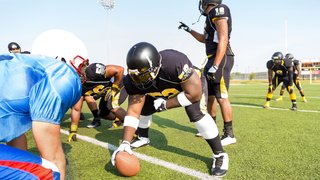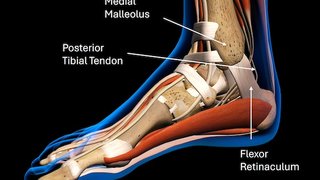Using ultrasound to diagnose sports injuries and joint pain is faster and less expensive
December 18, 2019

If you injure your knee, shoulder, or ankle while running or playing with your child, you might expect to be sent off for an X-ray or MRI. But more and more, hospitals are using in-room ultrasound to diagnose sports and joint injuries with less radiation exposure – and a smaller bill.
Ultrasound, also known as sonography, is an imaging method that uses high-frequency sound waves to produce images of structures inside the body. This technology, which is best known for helping see a baby in an expectant mother’s belly, can also help us see soft tissues that can’t be seen on X-ray or MRI, such as tendons or ligaments. Musculoskeletal ultrasound, or MSK, also can help measure bone density and help detect pinched nerves, abnormal growths, and even tumors.
Diagnostic ultrasound is not available in every clinic because it requires additional training and experience. Patients can access it in our new physical medicine and rehabilitation office at Frisco because I have credentialing in musculoskeletal ultrasound from the American Registry for Diagnostic Medical Sonography.
Ultrasound can help patients get a faster diagnosis, allow for immediate treatment planning, and get on the road to recovery more quickly. Let’s discuss a few of the advantages of diagnostic ultrasound and what to expect during the exam.
Meet Dr. Reed Williams: Diagnostic ultrasound expert
A former athlete, Dr. Williams has dedicated his career to helping people get back in the game. He is certified in musculoskeletal ultrasound, a leading-edge, non-invasive technique that can help diagnose soft tissue injuries, joint pain, and tendon and ligament damage. And he is bringing this technology to UT Southwestern's new medical facility in Frisco.
How patients can benefit from diagnostic ultrasound
Fewer appointments (and moving!)
Unlike with an X-ray or MRI, you don’t need to make another appointment or go to another office to get an ultrasound. This portable technology can be brought to your exam room or bedside.
Ultrasound is particularly helpful in diagnosing tough-to-image tissue, such as rotator cuff injuries. We can use a handheld ultrasound device to get a good look at the rotator cuff tendons and see whether there is a tear, strain, or a number of other pathologies – and you might be able to avoid lying in the tube of an MRI machine or moving into potentially uncomfortable positions for an X-ray.
Real-time results
Ultrasounds offer real-time feedback. If the exam reveals an issue, we can show you right on the screen what's wrong and immediately begin to discuss treatment options.
While X-rays and MRIs produce static images – a picture of one point in time in one position – ultrasounds have the ability to show the anatomy and the injury, in motion because it allows for dynamic imaging. If you tell us your arm or leg hurts when you move it a certain way, we can actually watch what’s happening with the muscles, tendons, and ligaments while in motion. You can watch, too, if you are up for it.
Less exposure
Ultrasounds use sound waves to produce images. They don’t use radiation like X-ray does, and so allows for prolonged and repeated exposure as needed. Unlike an MRI, ultrasounds don’t use magnetic fields that can affect pacemakers or other metal implants.
Lower cost
An ultrasound exam often costs less than an X-ray or MRI, and sometimes it is all the imaging we need to start a treatment plan.
What to expect during an ultrasound

An ultrasound usually takes about 30 minutes. We will have you sit or lie down on an exam table and apply a gel to the affected area. The gel prevents air pockets, which can block the sound waves, and allows the handheld device to slide easily and painlessly over the skin.
As the ultrasound transducer moves across your skin, it transmits sound waves from the ultrasound machine through the body. Those sound waves create an echo when they hit tissues.
The echoes are recorded, interpreted, and displayed as an image on a screen, and we watch the tissue in real time for signs of damage. We may ask you to move this way or that in order to see structures in your body in motion.
That’s it! Once we’re done, we wipe off the gel and discuss next steps, such as medication, physical therapy, and/or a minimally invasive procedure to correct the issue.
Limitations of ultrasound
There are instances in which an ultrasound won’t be able to tell us what’s wrong. Sound waves do not transmit well through dense structures, and imaging can be essentially blocked by these objects. For example, while ultrasounds can see the outer surface of bony structures and joints and the soft tissues surrounding them, they can’t penetrate bone. To visualize the internal structure of a bone, or inside of a bony-joint, we still need an X-ray or MRI.
Despite these limitations, ultrasounds can be a good first-line approach if we suspect the problem is in the muscle, tendon, or other soft tissues. It’s an important tool that can potentially help patients avoid unnecessary radiation exposure, save money, get a quicker diagnosis and plan, and then get back into action more quickly.
To make an appointment at the new UT Southwestern Frisco location, call 469-604-9000 or request an appointment online.










